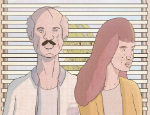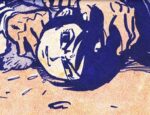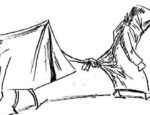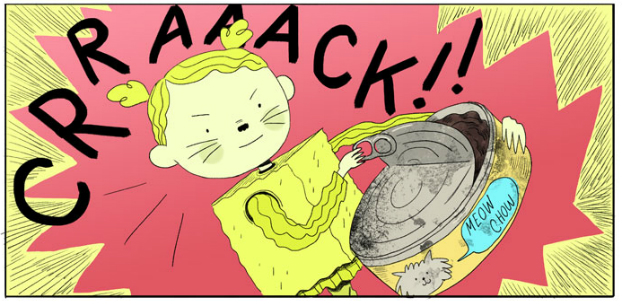
Pete Toms and Aleks Sennwald’s graphic novella The Short Con is on its surface the first of what hints at a larger series of children’s comics, but beneath that lies an examination of the power of belief. The way belief in ideas, no matter how outlandish, can give people the ability to achieve what was previously impossible. A fact that is especially true in children making the adventures of grade school detectives Pops & Branwell an engaging romp that, like the best of children’s entertainment, offers plenty for adults to sink their teeth into.
 The action in The Short Con follows the newly orphaned Mary Branwell as dragged by precocious fellow orphan Popowski (or Pops for short) into investigating the murder of her parents. Already leaning into the Dickensian, Toms and Sennwald then pivot to cop drama parody, as the entire orphanage has taken on role-playing as a police precinct. This intersection of real crime and make-believe police is a scenario that is also examined in the South Park episode ‘Lil’ Crime Stoppers’ but in that case as violent farce. Which is not to say that The Short Con doesn’t revel in dark humor – smash cuts to Branwell crying at the burned wreckage of her former home are punctuated by the ever smiling Pops commenting on how they can’t rely on anyone but themselves in this nightmare called life.
The action in The Short Con follows the newly orphaned Mary Branwell as dragged by precocious fellow orphan Popowski (or Pops for short) into investigating the murder of her parents. Already leaning into the Dickensian, Toms and Sennwald then pivot to cop drama parody, as the entire orphanage has taken on role-playing as a police precinct. This intersection of real crime and make-believe police is a scenario that is also examined in the South Park episode ‘Lil’ Crime Stoppers’ but in that case as violent farce. Which is not to say that The Short Con doesn’t revel in dark humor – smash cuts to Branwell crying at the burned wreckage of her former home are punctuated by the ever smiling Pops commenting on how they can’t rely on anyone but themselves in this nightmare called life.
Pops’ existential examinations are heady even for adults, as are her name checks of famous historical figures. Being a child she doesn’t quite grasp everything she is playing and mistakes the turnover of low income housing into condos as a vampiric conspiracy she calls “vampification.” The knowing adult chuckles to themselves and the child they are reading the comic with, along with Branwell, ponders the implications of a vampire take over. Just as the adult reader knowingly winks at the rookie and veteran cop dynamic Branwell and Pops are re-enacting with complete sincerity.
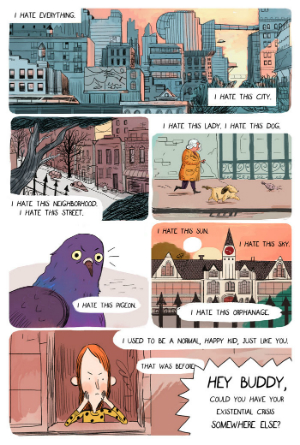 Yet it is this belief that Pops has in her identity as a detective that drives everything in the universe of The Short Con. Her belief is infectious. Others such as orphan tech wiz DPI, and the nun playing the role of police captain have all fully acclimated to their parts in this fiction. Branwell serves as our audience stand-in, at first not accepting this reality but eventually being drawn into it. When Branwell floats the more realistic idea that they could start by working on crimes like “late library fines” Pops, without hesitation, insists they jump right to solving the murder of Branwell’s parents. When donning cardboard and tin can dog costumes to try to sneak past robot guard dogs, Branwell is incredulous, but Pops tells her that working undercover is all about attitude. For their plan to work all she has to do is, “believe you’re a high-priced robot guard dog.”
Yet it is this belief that Pops has in her identity as a detective that drives everything in the universe of The Short Con. Her belief is infectious. Others such as orphan tech wiz DPI, and the nun playing the role of police captain have all fully acclimated to their parts in this fiction. Branwell serves as our audience stand-in, at first not accepting this reality but eventually being drawn into it. When Branwell floats the more realistic idea that they could start by working on crimes like “late library fines” Pops, without hesitation, insists they jump right to solving the murder of Branwell’s parents. When donning cardboard and tin can dog costumes to try to sneak past robot guard dogs, Branwell is incredulous, but Pops tells her that working undercover is all about attitude. For their plan to work all she has to do is, “believe you’re a high-priced robot guard dog.”
If Pops truly believes herself to be a detective then who is to say she is not? Especially as at the end of the story when she is the one who is able to solve the crime. This is “fake it until you make it” taken to a ridiculous end point. The theme of power of belief also extends to the villain of the story as well: a cat who wills himself to become human and take on the role of a butler. And in keeping with the dramatic tropes at play here, the butler did indeed do it.
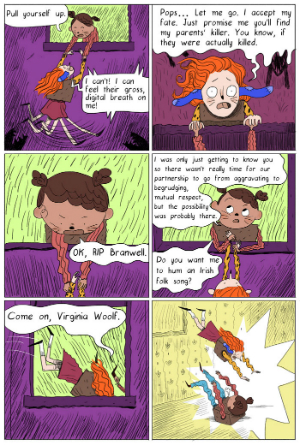 For all this meta-fiction, genre subversion, and existential pondering at work in the plot, the art is deeply grounded in the look of children’s comics. Svenwald’s characters are simply rendered but infinitely expressive. Spaghetti arms, wiggly rumpled sweaters and oversized heads make the reader empathize with our young protagonists. Grumpy floof cat Moesby and an angry pigeon are rife with character in their ridiculous performances. The reader can easily feel the exasperation of the real police called in to deal with Pops and Branwell’s antics. The coloring is masterfully done, handling much of the work of setting and tone in several sequences.
For all this meta-fiction, genre subversion, and existential pondering at work in the plot, the art is deeply grounded in the look of children’s comics. Svenwald’s characters are simply rendered but infinitely expressive. Spaghetti arms, wiggly rumpled sweaters and oversized heads make the reader empathize with our young protagonists. Grumpy floof cat Moesby and an angry pigeon are rife with character in their ridiculous performances. The reader can easily feel the exasperation of the real police called in to deal with Pops and Branwell’s antics. The coloring is masterfully done, handling much of the work of setting and tone in several sequences.
And while it is reminiscent of European color comics such as Jonathan Sfar’s work, there are far less areas of deep black and more electric color schemes. One major sequence uses a contrasting yellow and purple pallet to ratchet up the drama as the clues all come together in Pops’ brain. By the end young and old readers will come to care about this wacky but deeply alive cast of characters in this cartoon world and anticipate spending more time with them in their future adventures.
Though currently The Short Con is the only story in the Pops and Branwell Mysteries series, the potential for this project is unlimited. It is a testament to Toms and Sennwald’s abilities as creators that even though they both came up in the American indie comics scene, they were able to create wholesome mainstream entertainment without sacrificing an inch of their wit or craft. Getting to read the future hijinks of these junior detectives would only continue to showcase their masterful collaboration.
Pete Toms (W), Aleks Sennwald (A) • Study Group Comics, $9.95
Review by Robin Enrico





